
Heavy police sawhorses of rough wood with a stenciled warning — “Police Line Do Not Cross” — have been a visible staple of New York’s landscape for decades. But now they are being demoted.
Police Commissioner Raymond W. Kelly said that wooden sawhorses were being phased out. The last ones owned by the New York Police Department, made by inmates in upstate prisons, are being relegated to dull duty at street fairs and other low-impact events.
The glory, the front-row seats to history, will go to the interlocking gray aluminum partitions that the police call “French barriers.”
It’s like a first-grade detective in Midtown Manhattan being busted to overnight patrolman on the outskirts of Staten Island.
From a few hundred French barriers bought in the early 1990s, there are now about 12,000 (seven feet long and $70 each). Just 3,200 veteran wooden sawhorses (14 feet long and $60 each) remain. Other cities like Chicago and Philadelphia also use both types.
{ NY Times | Continue reading }
related:
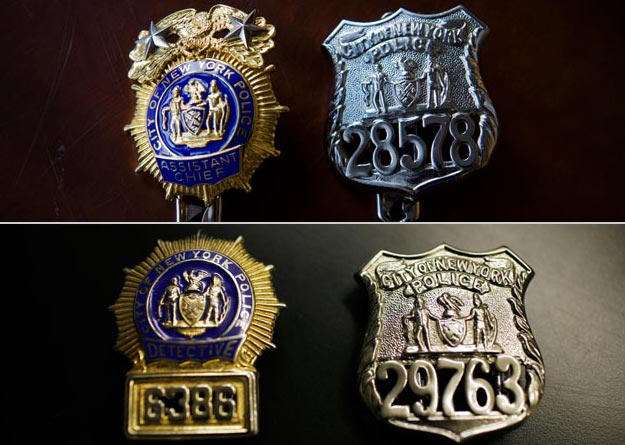
{ Top, fake badges for assistant chief and patrolman; bottom, real detective and patrolman badges. | In New York, some officers don’t wear their badges on patrol. Instead, they wear fakes. Called “dupes,” these phony badges are often just a trifle smaller than real ones but otherwise completely authentic. Officers use them because losing a real badge can mean paperwork and a heavy penalty, as much as 10 days’ pay. | NY Times | Continue reading }
architecture, new york, visual design | December 3rd, 2009 8:47 pm

The genome, as we all know, largely determines what we look like, our traits, and, significantly, our susceptibility to disease and other disorders. Ahituv is one of tens of thousands of well-funded researchers around the world trying to determine which segments of the genome contribute to which disorders. It is one of the biggest scientific endeavors in history, premised on the notion that the results can be used to prevent or fix many things, or possibly everything, that ails the human body — from allergies to cancer to aging itself. Dozens of biotech companies have sprung up in the past decade to commercialize this work, and one might assume that a stream of miracle pills will soon be on its way to our pharmacies.
You bet — just as soon as we work through a couple of hitches in this grand genomic enterprise. Scientists have indeed been superb at finding connections between disorders and various strips of DNA. But it turns out that in the vast majority of cases, these connections happen to be hideously convoluted, with any one disorder related to many genes and any one gene affecting many things in the body. Even when researchers are able to highlight a clear relationship between a single gene and a single disorder, they generally have little or no idea how those chunks of DNA are causing problems. (…)
It turns out that many dozens or even hundreds of genes each contribute to any given human attribute, and any one gene might contribute to several. Genes, in other words, turn out to work not as simple disease switches, but in impossibly complex networks.
{ The Gene Bubble: Why We Still Aren’t Disease-Free | Fast Company | Continue reading }
color lines { Ellsworth Kelly | Reifenhäuser }
Ellsworth Kelly, genes, science | November 25th, 2009 5:58 pm

{ This is the graph the record industry doesn’t want you to see. It shows the fate of the three main pillars of music industry revenue - recorded music, live music, and PRS revenues (royalties collected on behalf of artists when their music is played in public) over the last 5 years. | Times | Continue reading }
economics, music | November 25th, 2009 5:57 pm

But what do we mean by “art”?
Art is… what? A pursuit of excellence, a pursuit of meaning, a way of trying to make sense of the world. The arts, we’d say, are part of our life, our language, our way of seeing. The arts tell us truths about ourselves and each other and our society that reach parts of us that politics and journalism don’t. Art is passionate, ambiguous, complex, mysterious, and thrilling. It helps us to fit the disparate pieces of the world together; it helps us to try to make form out of chaos.
From all this I don’t imagine you’d dissent. And perhaps we could all agree on a hierarchy, a pantheon that would include, say, Shakespeare, Mozart, Bach, Beethoven, Rembrandt, Mahler, Matisse, Dickens, Beckett, Picasso, Stravinsky, Auden, Hughes, Renoir, Fellini, Orson Welles, Charlie Parker – and so on, all dead, all tested by time, all enduringly popular.
{ Richard Eyre/The Independent | Continue reading }
artwork { Roni Horn, Clown Mirror, 2001 | And more }
art, ideas | November 25th, 2009 5:52 pm
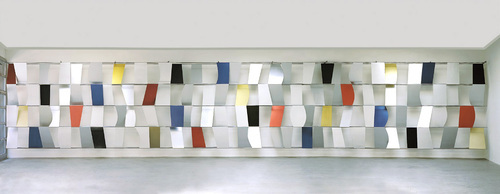
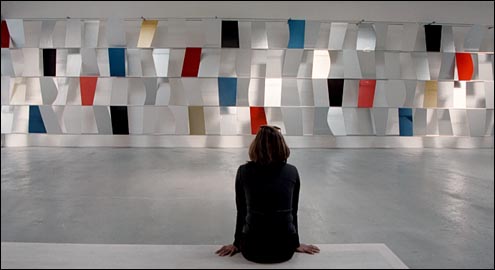

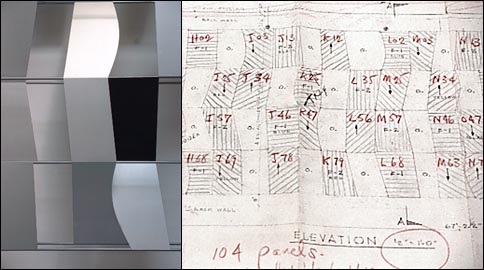
{ Ellsworth Kelly, Sculpture for a Large Wall, 1957 | 104 anodixed aluminum panels | MoMA }
In 1956, when he was 34 years old, Ellsworth Kelly was invited to create a sculpture for the lobby of Philadelphia’s Transportation Building which housed the old Greyhound Bus Terminal. The piece he made, Sculpture for a Large Wall, was the largest work of his career to that point.
{ ArtSeenSoho | Continue reading }
The Ellsworth Kelly “Sculpture for a Large Wall” was sold by Ronald Rubin for about $100,000. Then Matthew Marks turned around and sold it to the Lauder’s for about $1,000,000. The piece was later donated to MoMA by Carole and Ronald Lauder.
It was Kelly’s first sculpture, first commission and one of the first uses of anodized aluminum in fine art in America. The fact that no one complained when this unique masterpiece left Philadelphia while they raised $200,000 to retain Isiah Zagar’s kitschery makes Sid Sachs (director of the Rosenwald-Wolf Gallery at the University of the Arts) a very sad man. And the quality of the work and its importance is attested by the fact that MOMA used it every chance it could in ads and bus stop kiosks.
{ Roberta Fallon and Libby Rosof | Continue reading }
When Jeremy Wolfe of Harvard Medical School (…) wanted to illustrate how the brain sees the world and how often it fumbles the job, he flashed a slide of Ellsworth Kelly’s “Study for Colors for a Large Wall” on the screen, and the audience couldn’t help but perk to attention.
{ NY Times | Continue reading }
Ellsworth Kelly, archives, art | November 20th, 2009 12:01 pm

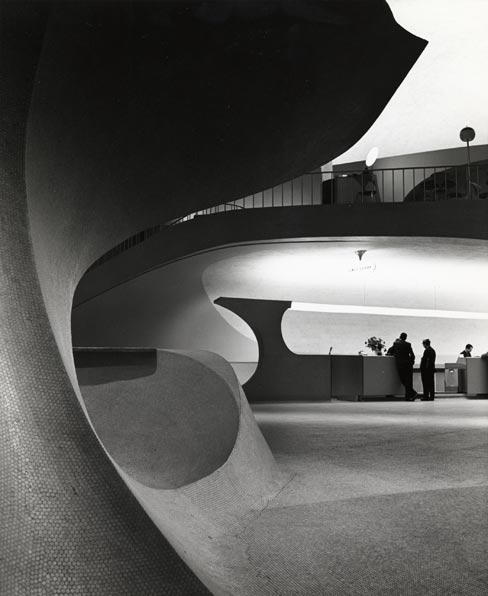
{ Eero Saarinen, TWA Terminal, New York International (now John F. Kennedy International) Airport, New York, circa 1962. | Photo: Balthazar Korab }
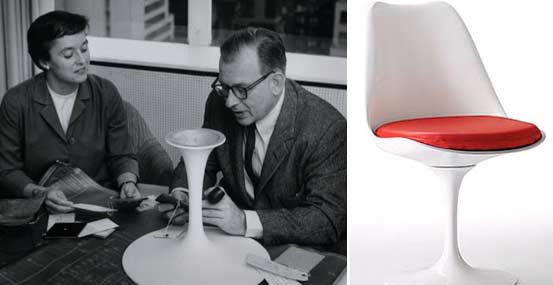

{ Eero Saarinen, Patent drawing for pedestal chairs, June 7, 1960 }

{ A new show champions the sinuous legacy of Eero Saarinen | Eero Saarinen: Shaping the Future | The Museum of the City of New York, from Nov 10, 2009 to January 31, 2010 | Press Realease | PDF | Catalog preview }
architecture, new york | November 19th, 2009 6:26 pm

The major fall art auctions may not have sold everything on offer, but collectors showed a renewed willingness to bid up top examples of artists’ work. (…) New York’s two chief auction houses, Sotheby’s and Christie’s International, brought in about $596 million combined from their semi annual sales of Impressionist, modern and contemporary art in the past two weeks. The total surpassed the houses’ $409 million spring sales in May, a gain that could signal a measure of returning confidence in high-end art values. (…)
For auction houses, these sales also marked the return of the guarantee, a financial mechanism in which an auction house promises to buy a work if it doesn’t sell at auction. Guarantees offer potential sellers a risk-free reason to part with their best pieces, but Sotheby’s and Christie’s stopped offering deal-sweeteners after suffering an estimated $63 million combined loss from unsold guaranteed artworks last November.
Now, auction houses are gingerly stepping back into such deals, but they’re mostly shifting the risk to third parties, typically dealers or collectors who agree to pay the seller a prearranged price for the work if it doesn’t ultimately fetch a higher price at auction.
{ Wall Street Journal | Continue reading }
artwork { Robert Gober, Untitled, 1993–94 | Beeswax, wood, glassine, and felt-tip pen }
art, economics | November 19th, 2009 6:22 pm

{ Vincent Van Gogh, Olive Trees with the Alpilles in the Background (1889) and Wheat Field with Cypresses (1889) }

{ Vincent Van Gogh, The Church at Auvers (1890), View of Arles with Irises (1888) and At Eternity’s Gate (1890) }
My dear Theo,
Yesterday Gauguin and I went to Montpellier to see the museum there. (…)
Gauguin and I talk a lot about Delacroix, Rembrandt &c.
The discussion is excessively electric. We sometimes emerge from it with tired minds, like an electric battery after it’s run down. (…)
Gauguin said to me this morning, when I asked him how he felt: ‘that he could feel his old self coming back’, which gave me great pleasure.
As for me, coming here last winter, tired and almost fainting mentally, I too suffered a little inside before I was able to begin to remake myself. (…)
As regards setting up a life with painters as pals, you see such odd things and I’ll end with what you always say, time will tell.
{ Letter from Vincent van Gogh to Theo van Gogh, 17 or 18 December 1888 | Continue reading | More: 902 letters from and to Van Gogh }
On 23 December 1888, frustrated and ill, Van Gogh confronted Gauguin with a razor blade. In panic, Van Gogh left their hotel and fled to a local brothel. While there, he cut off the lower part of his left ear lobe. He wrapped the severed tissue in newspaper and gave to a prostitute named Rachel, asking her to “keep this object carefully.”
Gauguin left Arles and never saw Van Gogh again.
{ Wikipedia | Continue reading }
art, flashback | November 13th, 2009 9:38 am

{ Press release entitled “? Bowie,” dating from 1966, in which the 19 year-old David Jones explains why he has adopted the stage name David Bowie, “There are too many David Jones’s.” | Christie’s }
music | November 13th, 2009 9:38 am

There is something to be said about fakes in tribal art, often seeming somehow to lack soul, and not quite having some kind of ring of truth. For example, they’re often somehow seemingly made to shock us, or to please us. The very finest works of tribal art, New Guinea art, or African art in my opinion, somehow have a lack of any interest in our perception at all, they’re sort of in another world. You can sort of see that in retrospect but can you always be certain with every piece you come across? No, I don’t think so.
{ The philosophy of authenticity, fakes and forgers | ABC | Continue reading }
artwork { Kefwele mask, Songye tribe, Congo }
art, ideas | November 7th, 2009 3:05 pm
art, photogs | November 6th, 2009 11:00 pm

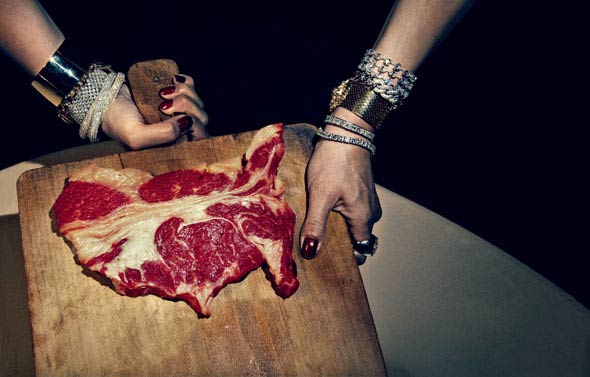
{ Linda Evangelista by Maurizio Cattelan, W magazine, Nov. 2009 | More photos | Behind the scene video }
related:
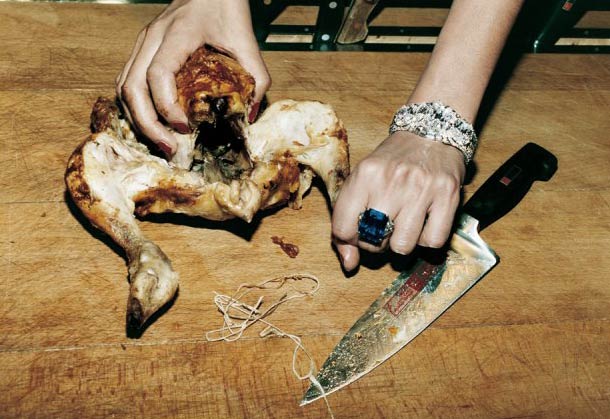
{ Helmut Newton, Allure magazine, 1997 }

{ Maurizio Cattelan | Bidibidobidiboo, 1996 | Him, 2001 | La Nona ora, 1999 | more }
Maurizio Cattelan, art, photogs | October 30th, 2009 9:04 am

{ Goya, Plate 39 from The Disasters of War, 1810-1820 }
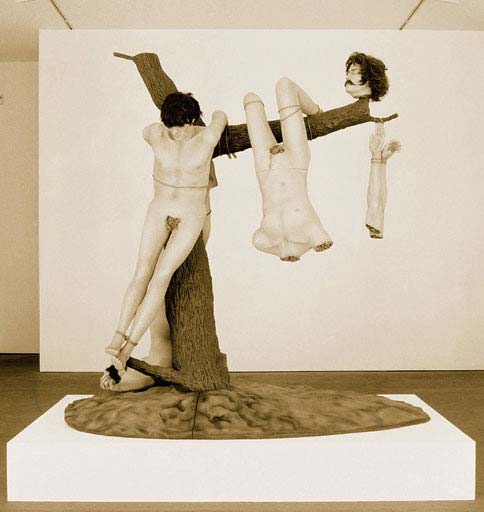
{ Jake and Dinos Chapman, Great Deeds Against the Dead, 1994 }
The Chapman brothers, fresh out of the Royal College of Art, had become obsessed with Goya’s gory ouvre - to the point, as Jake Chapman told me in a phone interview, that they later even considered changing their surname to Goya. They were especially haunted by the famous series of etchings known as “The Disasters of War”, in which Goya portrayed the atrocities he had witnessed in the Peninsular War between Spain and France (1808-1814) with a visceral horror. (…)
In 1994, they re-created plate 39 of “The Disasters of War - Great Feat! With Dead Men!” - on a larger scale, using nylon-wigged mannequins. Great Deeds Against the Dead (1994), which was their contribution to the legendary ‘Sensation’ exhibition at the Royal Academy, depicts three naked male bodies bound to a tree; blood dribbles from the crotches of these shop dummies where their genitalia would have been, if they’d ever had them. One victim’s arm dangles by its fingers from the makeshift gallows alongside the carcass of his torso, the severed head skewered on a branch.
{ Christopher Turner, editor at Cabinet magazine | Tate | Continue reading }



{ Jake and Dinos Chapman, Sex, 2003 }
With their bronze sculptures under the title “Sex” (2003), the Chapman brothers make a jump in time. They show the decomposed corpses from “Great Deeds Against the Dead” (1994). The bodies are swarming with flies, maggots, worms, and all sorts of creatures which have picked their bones clean. At first glance, everything seems naturalistic. It isn’t until one examines the work more closely and talks to the artists that one realizes the flies and worms were originally cheap plastic reproductions from toy stores and novelty shops. These were cast in bronze and hand-painted by the artists.
{ Absolute Arts | Continue reading | Art Net }

{ Jake and Dinos Chapman, Death, 2003 }
art, horror | October 30th, 2009 9:00 am
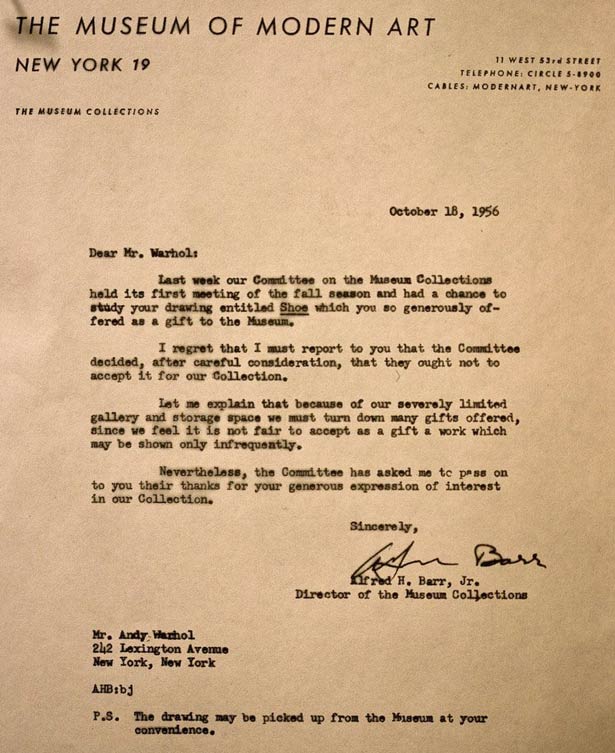
{ Moma rejection letter to Andy Warhol, 1956 | via Douglas Wilson | Enlarge }
art, flashback | October 30th, 2009 8:54 am

Fridays
• Museum of Modern Art - Free 4 to 8 p.m. (normally $20)
• Whitney Museum of American Art - Pay-what-you-wish 6 to 9 p.m. (normally $18)
(…)
Saturdays
• Guggenheim - Pay-what-you-wish 5:45 to 7:45 p.m. (normally $18)
{ Museum free hours in NYC for fall/winter 2009/10 | Newyorkology | Continue reading }
artwork { Ellsworth Kelly, Horizontal Line, 1951 }
Ellsworth Kelly, art, guide, new york | October 23rd, 2009 9:15 am
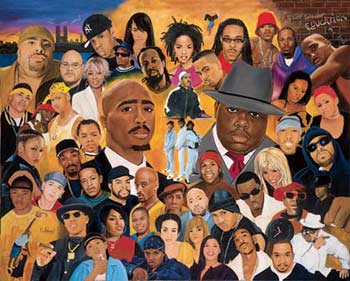
If I had to pick a year for hip-hop’s demise, though, I would choose 2009. (…) Jay-Z’s new album, “The Blueprint 3,” and some self-released mixtapes by Freddie Gibbs are demonstrating, in almost opposite ways, that hip-hop is no longer the avant-garde, or even the timekeeper, for pop music.
{ New Yorker | Continue reading }
music | October 23rd, 2009 9:15 am
bridges and tunnels, technology | October 23rd, 2009 9:10 am

{ New scientific techniques have uncovered evidence that this picture is a previously unrecognised work by Leonardo da Vinci. | Antique Trade Gazette | Continue reading }
art, technology | October 23rd, 2009 9:05 am

I try to do what Jeff Koons did when he put 1, 2 or 3 New Shelton Wet/Dry vacuums in a Plexiglas box, and added a title. I put news in Plexiglas boxes, and add titles.
It’s rather an experiment than journalism.
It’s about editing news, about the concept “editing/commenting is creating” developed a century ago when philosophers (Nietzsche, Heidegger, Deleuze, Foucault to name a few) made Philosophy by commenting past Philosophy.
Almost everything is quoted and nothing is signed: French writer Marguerite Yourcenar once said that it doesn’t matter who is writing. What matters is that it is written.
Also: Personality is like a collection of traits that we all share, and that we sometimes borrow from each other, but the totality (of qualities and traits) is peculiar to a specific person. That’s how one differs from another, by creating a different mix of existing traits, by tuning these traits to various degrees.
The word personality originates from the Latin persona, which means mask. We spend our life building this mask, and make it attractive, unique, different, coherent… It’s about editing traits and influences. It’s about creating something new from existing material.
artwork { Jeff Koons, New Hoover Convertibles, New Shelton Wet/Dry 10 Gallon Displaced Doubledecker, 1981-87 | Vacuum cleaners, Plexiglas and fluorescent lights | Photo: Thanks Daniel! }
related { Whether your earwax is wet or dry is determined by a mutation in a single gene, scientists have discovered. }
about, archives, jeff koons, science | October 2nd, 2009 12:49 pm







































